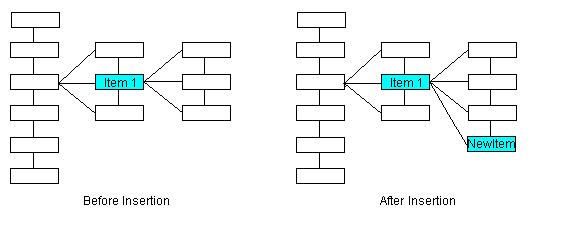InsertElement Method
Inserts a new element in the Data Set.
public DicomElement InsertElement(DicomElement neighbor,bool child,long tag,DicomVRType vr,bool sequence,int index)
Public Function InsertElement( _ByVal neighbor As DicomElement, _ByVal child As Boolean, _ByVal tag As Long, _ByVal vr As DicomVRType, _ByVal sequence As Boolean, _ByVal index As Integer _) As DicomElement
public DicomElement insertElement(DicomElement neighbor, boolean child, long tag, DicomVrType vr, boolean sequence, int index ) public:DicomElement^ InsertElement(DicomElement^ neighbor,bool child,int64 tag,DicomVRType vr,bool sequence,int index)
Parameters
neighbor
An item in the Data Set. The inserted item will be inserted as a neighbor to this item, or as a child, depending on the value of child.
child
true to insert the new item as the last child of neighbor; false to insert the new item as the last sibling of neighbor.
tag
Tag value for the inserted element. For a list of default values, refer to Data Element Tag Values.
vr
Value representation code that indicates the type of value stored in the data element.
sequence
true if the new item is a sequence; otherwise, false.
index
The index at which the data element should be inserted in a sequence. The index is zero-based, so if you want to insert a data element as the first item in the sequence, set this to 0. The value -1 indicates to add the data element to the end of the sequence.
A sequence may consist of one or more items. This parameter lets you insert a data element as any item within the sequence, not just at the end. In addition, it lets you insert multiple data elements within a sequence.
If neighbor points to the parent of a sequence and child is true, the index will pertain to the children of neighbor. If neighbor points to a member of a sequence and child is false, the index pertains to the siblings of neighbor.
Return Value
The newly inserted item.
The illustrations below show how items are added to the Data Set (internally maintained as a tree), based on the value of child. For the sake of these illustrations, the order of siblings is top to bottom. Therefore, since added items become the last sibling or the last child, these are drawn at the bottom of the appropriate group of items.
In this illustration, neighbor points to Item 1 and child is false. The new item is added as the last sibling of Item 1.

In this illustration, neighbor points to Item 1 and child is true. The new item is added as the last child of Item 1.

Reference
© 1991-2020 LEAD Technologies, Inc. All Rights Reserved.
